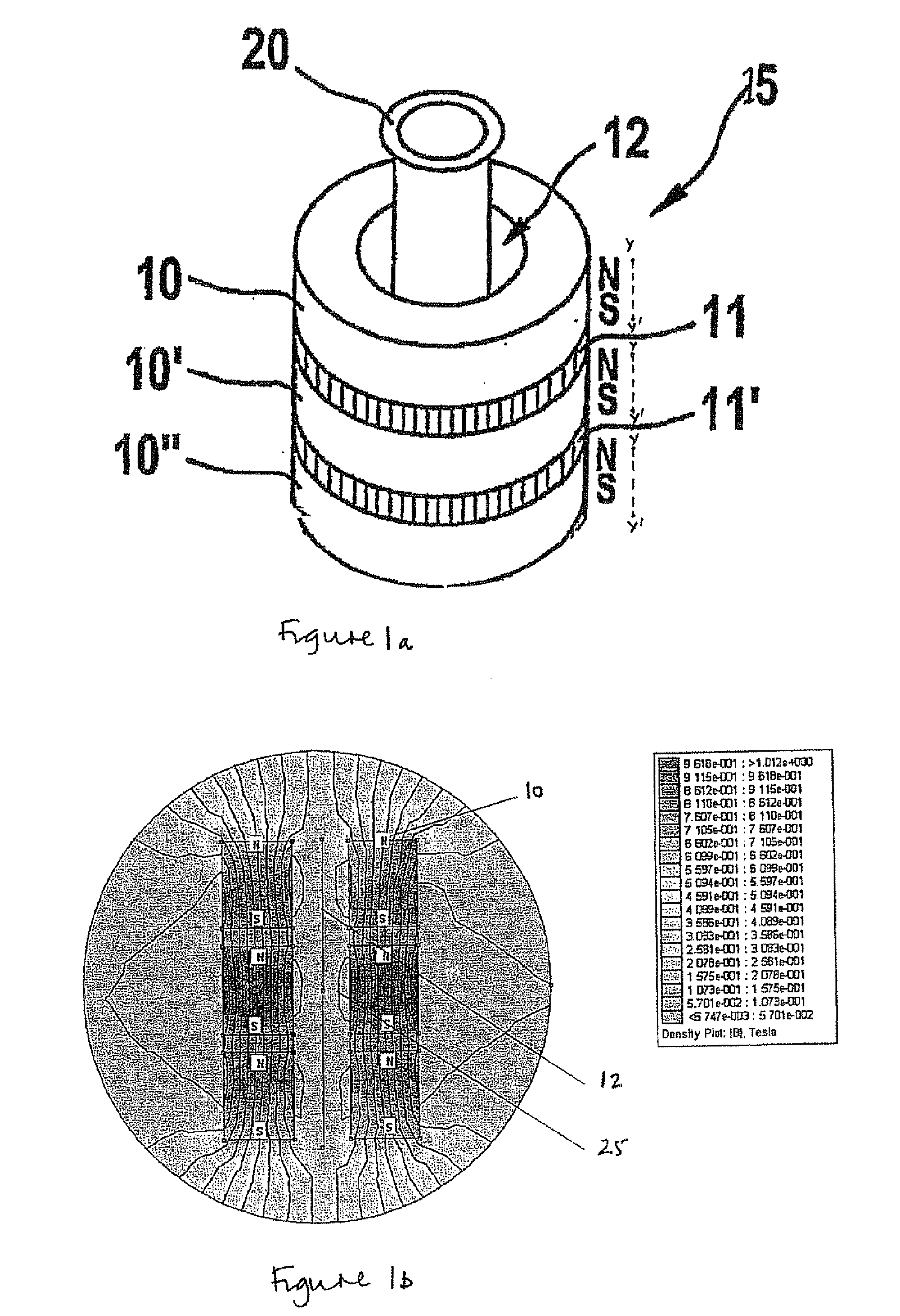Magnetising portion for a magnetic separation device
a magnetic separation device and magnetising portion technology, applied in the direction of magnetic separation, separation process, filtration separation, etc., can solve the problems of limited fringe magnetic field strength, weakening of affecting the strength of the fringe magnetic field
- Summary
- Abstract
- Description
- Claims
- Application Information
AI Technical Summary
Benefits of technology
Problems solved by technology
Method used
Image
Examples
first embodiment
[0096 of the Magnetising Portion
[0097]FIG. 3 depicts an embodiment of the magnetising portion (3) in its simplest form. The magnetising portion (3) comprises a single magnetic assembly with two magnets (M1, M2). The magnets are stacked substantially vertically, one above the other. The magnets are stacked such that the axes (Y-Y′) of each magnet extend substantially horizontally. The two magnets (M1, M2) are arranged such that the north and south poles of adjacent magnets are arrange alternately. The magnets (M1, M2) are bar shaped magnets with flat pole end faces (FEF). An aluminium spacing plate (SP) is arranged between the adjacent magnets; between magnets M1 and M2. The magnetic assembly has cuboid-like shape with two side walls (100, 101), two end faces (102,103), an upper surface (104) and a lower surface (105). End face 102 has a first alternating multipole surface with a NS configuration. End face 103 has a second alternating multipole surface with a SN configuration. The ma...
second embodiment
[0099 of the Magnetising Portion
[0100]FIG. 4a depicts a second embodiment of the magnetising portion (3) comprising two magnetic assemblies (3ma, 3mb). The magnetic assemblies are mounted in parallel relation. A central region, void or space is formed between the magnetic assemblies. The void is shaped such that it is suitable for receiving a sample vessel. The centre line, or central longitudinal axis of the magnetising portion (3) is marked X-X′. The central longitudinal axis is the furthest point within the central region from a magnetic assembly and therefore the most difficult area to influence. The first magnetic assembly (3ma) comprises three magnets (M1a-M3a). The magnets of the first magnetic assembly (3ma) are stacked vertically such that the alternating multipole surface facing the second magnetic assembly (3mb) has a NSN configuration. The second magnetic assembly (3mb) also comprises three magnets (M1b-M3b). The magnets of the second magnetic assembly (3mb) are stacked ...
third embodiment
[0104 of the Magnetising Portion
[0105]FIGS. 5a and 5b depict a third embodiment of the magnetising portion (3) comprising a plurality of magnetic assemblies (3ma-3mf) arranged in a substantially radial or circumferential configuration. The magnetic assemblies (3ma-3mf) are arranged in a substantially circumferential array about a magnetic assembly mounting portion (MP).
[0106]Each magnetic assembly comprises two magnets, a first magnet (M1) and a second magnet (M2). The magnets (M1, M2) are stacked vertically in an alternating multipole configuration. An aluminium spacing plate (SP) is arranged between the adjacent magnets. Each magnetic assembly has a first alternating multipole surface with a SN configuration and a second alternating multipole surface with a NS configuration. However, the magnetic field of the second alternating multipole surface is restricted by the magnetic assembly mounting portion (MP). The magnetising portion is configured such that, in use, the first alternat...
PUM
| Property | Measurement | Unit |
|---|---|---|
| volume | aaaaa | aaaaa |
| diameter | aaaaa | aaaaa |
| volumes | aaaaa | aaaaa |
Abstract
Description
Claims
Application Information
 Login to View More
Login to View More - R&D
- Intellectual Property
- Life Sciences
- Materials
- Tech Scout
- Unparalleled Data Quality
- Higher Quality Content
- 60% Fewer Hallucinations
Browse by: Latest US Patents, China's latest patents, Technical Efficacy Thesaurus, Application Domain, Technology Topic, Popular Technical Reports.
© 2025 PatSnap. All rights reserved.Legal|Privacy policy|Modern Slavery Act Transparency Statement|Sitemap|About US| Contact US: help@patsnap.com



